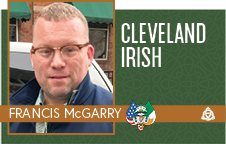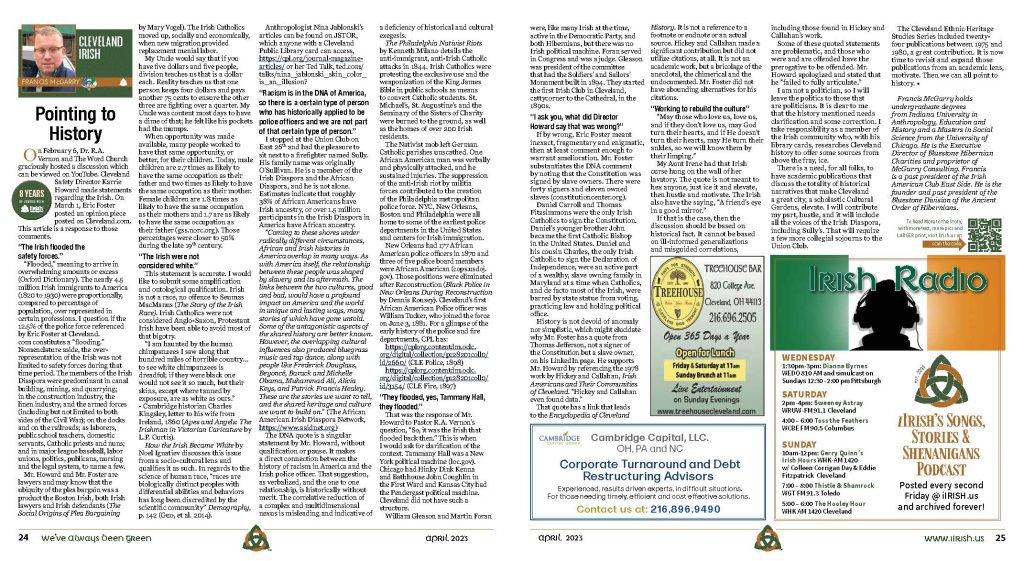

Cleveland Irish: Pointing to History
By Francis McGarry
On February 6, Dr. R.A. Vernon and The Word Church graciously hosted a discussion which can be viewed on YouTube. Cleveland Safety Director Karrie Howard made statements regarding the Irish. On March 1, Eric Foster posted an opinion piece posted on Cleveland.com. This article is a response to those comments.
“The Irish flooded the safety forces.”
“Flooded,” meaning to arrive in overwhelming amounts or excess (Oxford Dictionary). The nearly 4.5 million Irish immigrants to America (1820 to 1930) were proportionally, compared to percentage of population, over represented in certain professions. I question if the 12.5% of the police force referenced by Eric Foster at Cleveland.com constitutes a “flooding.” Nomenclature aside, the over-representation of the Irish was not limited to safety forces during that time period. The members of the Irish Diaspora were predominant in canal building, mining, and quarrying; in the construction industry, the linen industry, and the armed forces (including but not limited to both sides of the Civil War); on the docks and on the railroads; as laborers, public school teachers, domestic servants, Catholic priests and nuns; and in major league baseball, labor unions, politics, publicans, nursing and the legal system, to name a few.
Mr. Howard and Mr. Foster are lawyers and may know that the ubiquity of the plea bargain was a product the Boston Irish, both Irish lawyers and Irish defendants (The Social Origins of Plea Bargaining by Mary Vogel). The Irish Catholics moved up, socially and economically, when new migration provided replacement menial labor.
My Uncle would say that if you have five dollars and five people, division teaches us that is a dollar each. Reality teaches us that one person keeps four dollars and pays another 75 cents to ensure the other three are fighting over a quarter. My Uncle was content most days to have a dime of that; he felt like his pockets had the mumps.
When opportunity was made available, many people worked to have that same opportunity, or better, for their children. Today, male children are 2.7 times as likely to have the same occupation as their father and two times as likely to have the same occupation as their mother. Female children are 1.8 times as likely to have the same occupation as their mothers and 1.7 are as likely to have the same occupation as their father (father (gss.norc.org). Those percentages were closer to 50% during the late 19th century.
“The Irish were not considered white.”
This statement is accurate. I would like to submit some amplification and ontological qualification. Irish is not a race, no offence to Seumas MacManus (The Story of the Irish Race). Irish Catholics were not considered Anglo-Saxon, Protestant Irish have been able to avoid most of that bigotry.
“I am haunted by the human chimpanzees I saw along that hundred miles of horrible country…to see white chimpanzees is dreadful; if they were black one would not see it so much, but their skins, except where tanned by exposure, are as white as ours.” – Cambridge historian Charles Kingsley, letter to his wife from Ireland, 1860 (Apes and Angels: The Irishman in Victorian Caricature by L.P. Curtis).
How the Irish Became White by Noel Ignatiev discusses this issue from a socio-cultural lens and qualifies it as such. In regards to the science of human race, “races are biologically distinct peoples with differential abilities and behaviors has long been discredited by the scientific community” Demography, p. 142 (Guo, et al. 2014).
Anthropologist Nina Jablonski’s articles can be found on JSTOR, which anyone with a Cleveland Public Library card can access, https://cpl.org/journal-magazine-articles/ or her Ted Talk, ted.com/talks/nina_jablonski_skin_color_is_an_illusion?
“Racism is in the DNA of America, so there is a certain type of person who has historically applied to be police officers and we are not part of that certain type of person.”
I stopped at the Union Club on East 26th and had the pleasure to sit next to a firefighter named Sully. His family name was originally O’Sullivan. He is a member of the Irish Diaspora and the African Diaspora, and he is not alone. Estimates indicate that roughly 38% of African Americans have Irish ancestry, or over 1.5 million participants in the Irish Diaspora in America have African ancestry.
“Coming to these shores under radically different circumstances, African and Irish histories in America overlap in many ways. As with America itself, the relationship between these people was shaped by slavery and its aftermath. The links between the two cultures, good and bad, would have a profound impact on America and the world in unique and lasting ways, many stories of which have gone untold. Some of the antagonistic aspects of the shared history are better known. However, the overlapping cultural influences also produced bluegrass music and tap dance, along with people like Frederick Douglass, Beyoncé, Barack and Michelle Obama, Muhammad Ali, Alicia Keys, and Patrick Francis Healey. These are the stories we want to tell, and the shared heritage and culture we want to build on.” (The African American Irish Diaspora Network, https://www.aaidnet.org)
The DNA quote is a singular statement by Mr. Howard, without qualification or pause. It makes a direct connection between the history of racism in America and the Irish police officer. That suggestion, as verbalized, and the one to one relationship, is historically without merit. The correlative reduction of a complex and multidimensional nexus is misleading and indicative of a deficiency of historical and cultural exegesis.
The Philadelphia Nativist Riots by Kenneth Milano details the anti-immigrant, anti-Irish Catholic attacks in 1844. Irish Catholics were protesting the exclusive use and the weaponization of the King James Bible in public schools as means to convert Catholic students. St. Michael’s, St. Augustine’s and the Seminary of the Sisters of Charity were burned to the ground, as well as the homes of over 200 Irish residents.
The Nativist mob left German Catholic parishes unscathed. One African American man was verbally and physically attacked, and he sustained injuries. The suppression of the anti-Irish riot by militia forces contributed to the creation of the Philadelphia metropolitan police force. NYC, New Orleans, Boston and Philadelphia were all home to some of the earliest police departments in the United States and centers for Irish immigration.
New Orleans had 177 African American police officers in 1870 and three of five police board members were African American (cops.usdoj.gov). Those positions were eliminated after Reconstruction (Black Police in New Orleans During Reconstruction by Dennis Rousey). Cleveland’s first African American Police officer was William Tucker, who joined the force on June 3, 1881. For a glimpse of the early history of the police and fire departments, CPL has:
https://cplorg.contentdm.oclc.org/digital/collection/p128201coll0/id/2660/ (CLE Police, 1898) https://cplorg.contentdm.oclc.org/digital/collection/p128201coll0/id/3154/ (CLE Fire, 1897)
“They flooded, yes, Tammany Hall, they flooded.”
That was the response of Mr. Howard to Pastor R.A. Vernon’s question, “So, it was the Irish that flooded back then.” This is when I would ask for clarification of the context. Tammany Hall was a New York political machine (loc.gov). Chicago had Hinky Dink Kenna and Bathhouse John Coughlin in the First Ward and Kansas City had the Pendergast political machine. Cleveland did not have such a structure.
William Gleason and Martin Foran were, like many Irish at the time, active in the Democratic Party, and both Hibernians, but there was no Irish political machine. Foran served in Congress and was a judge. Gleason was president of the committee that had the Soldiers’ and Sailors’ Monument built in 1894. They started the first Irish Club in Cleveland, cattycorner to the Cathedral, in the 1890s.
“I ask you, what did Director Howard say that was wrong?”
If by wrong, Eric Foster meant inexact, fragmentary and enigmatic, then at least comment enough to warrant amelioration. Mr. Foster substantiates the DNA comment by noting that the Constitution was signed by slave owners. There were forty signers and eleven owned slaves (constitutioncenter.org).
Daniel Carroll and Thomas Fitzsimmons were the only Irish Catholics to sign the Constitution. Daniel’s younger brother John became the first Catholic Bishop in the United States. Daniel and his cousin Charles, the only Irish Catholic to sign the Declaration of Independence, were an active part of a wealthy, slave owning family in Maryland at a time when Catholics, and de facto most of the Irish, were barred by state statue from voting, practicing law and holding political office.
History is not devoid of anomaly nor simplistic, which might elucidate why Mr. Foster has a quote from Thomas Jefferson, not a signer of the Constitution but a slave owner, on his LinkedIn page. He supports Mr. Howard by referencing the 1978 work by Hickey and Callahan, Irish Americans and Their Communities of Cleveland. “Hickey and Callahan even found data.”
That quote has a link that leads to the Encyclopedia of Cleveland History. It is not a reference to a footnote or endnote or an actual source. Hickey and Callahan made a significant contribution but did not utilize citations, at all. It is not an academic work, but a bricolage of the anecdotal, the chimerical and the undocumented. Mr. Foster did not have abounding alternatives for his citations.
“Working to rebuild the culture”
“May those who love us, love us, and if they don’t love us, may God turn their hearts, and if He doesn’t turn their hearts, may He turn their ankles, so we will know them by their limping.”
My Aunt Irene had that Irish curse hung on the wall of her lavatory. The quote is not meant to hex anyone, just ice it and elevate, then hustle and motivate. The Irish also have the saying, “A friend’s eye in a good mirror.”
If that is the case, then the discussion should be based on historical fact. It cannot be based on ill-informed generalizations and misguided correlations, including those found in Hickey and Callahan’s work.
Some of these quoted statements are problematic, and those who were and are offended have the prerogative to be offended. Mr. Howard apologized and stated that he “failed to fully articulate.”
I am not a politician, so I will leave the politics to those that are politicians. It is clear to me that the history mentioned needs clarification and some correction. I take responsibility as a member of the Irish community who, with his library cards, researches Cleveland history to offer some sources from above the fray, ice.
There is a need, for all folks, to have academic publications that discuss the totality of historical narratives that make Cleveland a great city, a scholastic Cultural Gardens, elevate. I will contribute my part, hustle, and it will include all the voices of the Irish Diaspora, including Sully’s. That will require a few more collegial sojourns to the Union Club.
The Cleveland Ethnic Heritage Studies Series included twenty-four publications between 1975 and 1980, a great contribution. It is now time to revisit and expand those publications from an academic lens, motivate. Then we can all point to history.
*Francis McGarry holds undergraduate degrees from Indiana University in Anthropology, Education and History and a Masters in Social Science from the University of Chicago. He is the Executive Director of Bluestone Hibernian Charities and proprietor of McGarry Consulting. Francis is a past president of the Irish American Club East Side. He is the founder and past president of the Bluestone Division of the Ancient Order of Hibernians.


Monthly newsmagazine serving people of Irish descent from Cleveland to Clearwater. We cover the movers, shakers & music makers each and every month.
Since our 2006 inception, iIrish has donated more than $376,000 to local and national charities.
GET UPDATES ON THE SERIOUS & THE SHENANIGANS!